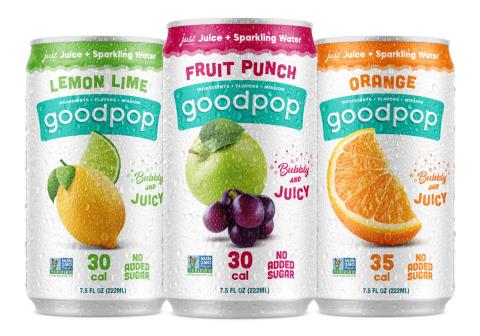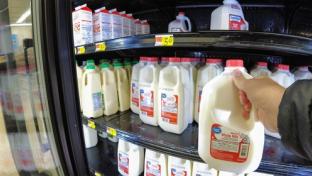Milk and Juice Fight to Retain Their Healthy Halos
More Dairy Coverage
Milk and juice — two longtime staples of healthy eating — have faced challenges from health-conscious consumers looking for low-calorie and reduced-fat foods. While both beverages contain many natural health benefits, consumers have been exploring other alternatives of late. That may be changing, however.
“Consumers are looking at beverage claims or attributes as shortcuts to understanding a beverage’s impact on their health and wellness,” says Melissa Abbott, VP of syndicated studies at The Hartman Group, in Bellevue, Wash. “Seeking fewer calories has become an easy-to-follow approach that replaces the need to evaluate the source of calories for dairy milks and functional juices.”
[Read more: "Fresh Juice-Based Beverages Move Into Mainstream"]
According to experts, good nutrition isn’t always that simple. “When looking at your diet as a whole, it’s important to consider a food’s full nutrient package,” advises Laura Buxenbaum, MPH, RD, LDN and senior director, health and wellness at The Dairy Alliance, in Atlanta. “Many foods with naturally occurring sugars, like milk or fruit, also offer nutritious vitamins, minerals, protein, fiber or bioactives that can benefit our health.”

Consumers Get Smarter About Nutrition
Research suggests that consumers are becoming more discerning when they assess overall food nutritional profiles. In addition, shifting consumer preferences and other market forces are causing consumers to reconsider these two key categories. A recent report from Chicago-based market research firm Mintel has found that rising inflation and an uptick in at-home eating have given the dairy milk category a boost.
“Price, as well as assessments of holistic value created by taste, nutrition and versatility, led consumers to put a pause on their exploration of the nondairy category and opt for more familiar and reliable dairy milk offerings,” Mintel’s reports notes.
[Read more: "Winning Over the ‘Not Milk’ Generation"]
Mintel’s research indicates that 80% of parents agree it’s important for their children to drink dairy milk — more good news for the milk category. Manufacturers are introducing niche products with innovative claims and benefits, among them added protein, rBST-free and functional attributes, that tap into renewed interest in dairy milk.
“Consumer data shows us that value-added milk consumption is on the rise,” says Buxenbaum. “Consumers like variety, choices and products that they feel are personalized to them, and dairy milk has a variety of products that fit any lifestyle.”
Focus on Digestibility
Lactose-free milk is one segment experiencing a surge among health-conscious consumers, due to its lower calorie content and easier digestibility, according to research from Future Market Insights. The Newark, Del.-based market research firm predicts that as more people prioritize healthier choices, the appeal of lactose-free products is expected to continue to increase, reshaping the landscape of consumer preferences.
Interest in A2 milk is also growing. All dairy milk contains beta-casein, a common protein, but the breed of cow that’s the source of the milk determines whether milk contains A1 or A2 beta-casein, or both. Some studies suggest a link between A1 milk and diabetes and heart disease as well as digestive issues, although studies in this area are inconclusive and ongoing.
A2 milk is certainly on consumers’ radar, and the subcategory is outpacing the growth of both the premium/specialty segment and the overall milk category. “Our body of scientific research clearly points out that for those individuals that have trouble digesting milk, A2 milk is easier on digestion,” asserts Edith Bailey, global CMO at The a2 Milk Co. Launched in New Zealand in 2000 and based in that country’s capital city, Auckland, The a2 Milk Co. saw its brand grow by 27% in the United States last year.
According to Bailey, availability of A2 milk products is good news for the millions of consumers who have trouble digesting milk. Many consumers, she notes, view the products as an elevated-quality premium milk. “Our growth rate, combined with our CAGR since launch, provides strong evidence that consumers understand the benefits and are interested in our value proposition,” she says. The company recently added a2 Milk Grassfed Whole Milk and a2 Milk Grassfed 2% Reduced Fat Milk to its portfolio.
Meanwhile, fairlife, a brand of The Coca‑Cola Co., based in Atlanta, has been expanding with premium products such as ultra-filtered milk. The brand, which brought higher protein, lower sugar and distinctive packaging to the category, has been growing, with a new manufacturing plant recently added in New York state set to fuel expansion.
Boston-based Slate Milk, a boosted-protein line of all-natural canned chocolate milk and latte products, has also seen significant expansion and is now carried in more than 10,000 retail stores across the country.

Consumers Reconsider Juice
In the juice category, consumers are more likely to accept natural sweeteners than in many other beverages. The Hartman Group’s Abbott observes that juice consumers don’t mind a moderate sugar and calorie profile as long as products deliver on taste and functionality.
“Juice drinkers are likely to look for simple and natural ingredients, and avoid juices with artificial low-calorie sweeteners, despite their ability to reduce calories,” she notes. “We can expect to see rising interest in fruit juices sweetened with a blend of real sugar and alternatives like monk fruit as a way to mitigate sugar grams and calories.”
As part of a strategy to accelerate the development of products aimed at health-conscious consumers, Chico, Calif.-based R.W. Knudsen recently launched a line of lower-calorie, lower-sugar juice beverages. Formulated without sucralose or high-fructose corn syrup, the lineup consists of eight new flavors, including cranberry, mango passionfruit, tart cherry and tropical blend. Langers, for its part, has added a 5 Calorie Pineapple juice to its lineup. With only 5 calories and 2 grams of carbs per serving, the product still boasts 80% of the daily value of vitamin C in one cup.
“Consumers are looking for the natural goodness and benefits fruits bring to the table, such as vitamin C and antioxidants, but there’s heightened awareness and concern about sugar intake,” says Bruce Langer, president of City of Industry, Calif.-based Langer Juice Co. “This is where juices with a lower-calorie profile step in.”
This summer, category powerhouse Tropicana launched Tropicana Zero Sugar, an assortment with zero sugar and no artificial sweetener ingredients. The line is available in a 52-ounce bottle in three flavors: Summer Splash Punch, Lively Lemonade and Passionfruit Lemonade Escape.
The brand of Purchase, N.Y.-based PepsiCo also recently relaunched Trop50 as Tropicana Light. The renamed beverage delivers 100% of your daily dose of vitamin C and is a good source of potassium, but contains 50% less sugar and 50% fewer calories than regular orange juice, as well as no artificial sweeteners.
Among smaller companies, Austin, Texas-based frozen treat brand GoodPop has expanded into the beverage aisle with Mini Cans, lunchbox-size 7.5-ounce drinks made with real fruit juice and sparkling water, but no added sugars, sweeteners or flavors. The line comes in Fruit Punch, Orange and Lemon Lime flavors.
Manufacturers are also exploring new health angles for juice products. Scrubber, for example, is a recent functional juice introduction that boasts a hefty 15 grams of fiber per serving. “Our team recognized the demand for fiber and chose to address this need, says Michael Pizzimenti, general manager of Scrubber, which is made by a company based in Jakarta, Indonesia.
Pizzimenti adds that the product “is the first juice-based drink to provide more than half of your daily fiber requirements, without any artificial sweeteners or added sugar. This innovation not only caters to taste and nutrition, but contributes significantly to the importance of gut health.”








